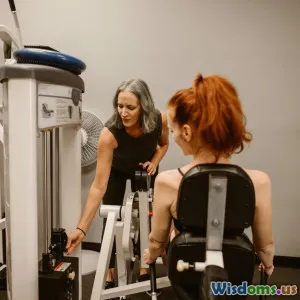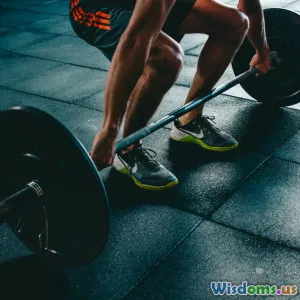
The Surprising Benefits of Micro Workouts for Busy Professionals
16 min read Discover how micro workouts can transform fitness for busy professionals, offering big results in little time, supported by science, examples, and actionable strategies. (0 Reviews)
The Surprising Benefits of Micro Workouts for Busy Professionals
Introduction
Imagine transforming your health, energy, and productivity—without ever stepping foot in a gym or spending hours you don’t have. For busy professionals juggling looming deadlines, endless meetings, and family obligations, the pursuit of fitness often feels impossible. But what if five, ten, or even three-minute bursts of movement could make all the difference? Welcome to the world of micro workouts—a revolution for those with packed calendars.
Gone are the days when only hour-long sessions at dawn or twice-weekly gym marathons counted as meaningful exercise. Increasingly, science and real-world stories show that short, frequent spurts of movement can deliver outsized benefits. Micro workouts not only optimize physical health; they boost productivity, elevate mood, and fit seamlessly into even the most hectic of schedules. In this article, we’ll reveal the surprising science behind micro workouts, real-life examples of their power, and practical ways to make them part of your daily grind. If you're ready to unlock major gains with minimal time investment, read on.
Table of Contents
- What Are Micro Workouts? Setting the Stage
- How Micro Workouts Boost Health
- Mental and Emotional Benefits
- Productivity and Performance: The Work Benefits
- Science-Backed Evidence: Micro Workouts in Research
- Real-World Success Stories
- How to Integrate Micro Workouts Into a Busy Day
- Common Myths Debunked
- Conclusion: Small Changes, Big Results
1. What Are Micro Workouts? Setting the Stage
Micro workouts refer to short, intense or moderate bursts of physical activity—typically ranging from 1 to 15 minutes—performed intermittently throughout the day. Unlike standard workouts, micro workouts can be done just about anywhere: your living room between Zoom meetings, a stairwell during your coffee break, or even while dinner simmers on the stove.
Key Features of Micro Workouts:
- Duration: Usually 1-15 minutes
- Frequency: Multiple times a day
- Location: Home, office, outdoors—no gym required
- Intensity: Moderate to vigorous, but always flexible
Examples include:
- 10 push-ups every hour
- 5-minute brisk walks between calls
- Two sets of jumping jacks after opening your email inbox
- 60-second plank during lunch
- Climbing stairs instead of taking the elevator
Origins and Growth: The emergence of micro workouts taps into a growing recognition that every bit of movement counts. Apple’s “Stand” ring, Fitbit’s reminders to move, and viral fitness challenges all capitalize on micro workout principles.
As Dr. Martin Gibala, author of “The One-Minute Workout” and professor at McMaster University, notes: "It’s increasingly unclear whether daily exercise needs to come all at once for optimal benefit. Accumulated short bursts really do matter."
2. How Micro Workouts Boost Health
Despite the brevity of micro workouts, their effect on physical health isn’t miniature—in fact, it’s inspiring. Researchers and fitness professionals now agree that even short, regular bouts of activity can contribute meaningfully to cardiovascular health, metabolic function, strength, and more.
Heart Health Gains
A major study published in the Journal of the American Heart Association found that spread-out, short episodes of moderate-to-vigorous activity correlate with reductions in cardiovascular disease risk, comparable to those who exercise for sustained periods. The authors concluded, "Every minute counts toward heart health."
Metabolism and Weight Management
Short, high-intensity activity—think a minute of burpees or several flights of stairs—can spur the metabolism. According to a 2019 review in Obesity Reviews, cumulatively, micro workouts can help control glucose, regulate insulin, and enhance fat metabolism just as well as traditional sessions—especially when done consistently.
Muscular Strength and Mobility
When spread throughout the day, bodyweight movements (like squats or lunges) help maintain lean muscle and prevent the sedentary muscle atrophy common among desk-bound professionals. Over weeks, something as simple as 3-minute “exercise snacks” three times daily leads to real strength gains, according to a 2022 study by the University of Bath.
Fact: Adults who replace 30 minutes of sitting per day with even light activity decrease risk of premature death by 17% (American Journal of Preventive Medicine, 2020).
Health Metrics Without the Marathon
Compared to extended gym routines, micro workouts are more likely to be consistently performed—and consistency is the undisputed king of fitness progress.
3. Mental and Emotional Benefits
Fitness isn’t just about the body. For busy professionals contending with workplace stress, a cloudy mind, or waning motivation, micro workouts can offer crucial mental resets.
Boosted Mood and Stress Relief
The psychological effects of physical movement—even in brief bursts—are well-documented. Endorphins released through activity combat stress and anxiety, while micro workouts introduce structured breaks that refresh focus.
Dr. Wendy Suzuki, neuroplasticity researcher and author of "Healthy Brain, Happy Life", highlights: "A one-minute burst can lift mood instantly, reduce anxiety, and help reset your day." Her research points to regular movement, however brief, as a powerful moderator of workplace burnout.
Sharpened Focus and Cognitive Function
Research from Stanford University illustrates that exercise increases blood flow to the brain, sharpening memory, creativity, and executive function. When peppered throughout your day, these benefits can directly translate to smarter decisions and clearer thinking at work.
Example: Health tech companies like Google and Atlassian now recommend mini movement breaks—not just for wellness, but as productivity tools—embedding squats, stretches, or quick walks into daily workflows.
Building Mindful Habits
Aside from physiological effects, the simple act of stepping away from the desk for deliberate movement fosters mindfulness—refocusing attention and breaking rumination cycles common in stressful environments.
\
4. Productivity and Performance: The Work Benefits
For many, exercising seems at odds with getting work done. Paradoxically, micro workouts may be your secret weapon for not just surviving, but thriving in fast-paced professional settings.
Energy Cycles and Peak Performance
Human minds and bodies operate in ultradian cycles—90-120 minute posers of productivity followed by troughs. Incorporating short exercise breaks at these transition points reliably increases alertness.
Real-World Application:
- Pomodoro Movement Breaks: After every fourth Pomodoro (focused work sprint), take a 5-minute active break: wall-sits, downward dogs, or jogging in place.
- Standing Meeting Sprints: Integrated stretch or squat breaks during meetings improve engagement and break up mental fatigue.
A survey by Tork North America (2021) found nearly 90% of office workers feel more energized after taking an activity break—even when it’s less than 3 minutes.
Reducing Physical Discomfort
Desk jobs can wreak havoc on the back, neck, and hips. Frequent small movement disrupts poor posture patterns and maintains mobility, preventing repetitive strain injuries.
ROI: Returns on a Micro Investment
By swapping one five-minute coffee scroll per hour for a micro workout, you’re not losing time—you’re gaining energy and focus. This trade-off often results in a net productivity boost: more work done, better mood, and healthier body.
5. Science-Backed Evidence: Micro Workouts in Research
Studies over the past decade have steadily torn down the myth that only long-duration workouts yield real health dividends.
Key Studies Supporting Micro Workouts
- A large JAMA Internal Medicine study followed 350,000 US adults for over 10 years. Those who accumulated at least 150 minutes of moderate activity per week through short bouts reduced their all-cause mortality by 31%, mirroring more traditional exercisers.
- A 2020 study in Cell Metabolism found that just 3 x 20-second cycling sprints performed three times a week rapidly improved cardiovascular health and insulin sensitivity comparable to 45-minute moderate-intensity workouts.
- The University of British Columbia demonstrated that triaging vigorous movement into bite-sized daily doses preserves executive function and short-term memory in middle-aged professionals.
Quote: “Short bursts of activity stacked through the day can make a huge difference. It’s the message of ‘some is better than none, and more is better than some,’” says Dr. Stuart Biddle, professor of physical activity & health.
The Power of Consistency
Because micro workouts are easier to stick with, especially for professionals, adherence rates are higher. This adherence—over months and years—is where the real power lies.
6. Real-World Success Stories
The Consultant
A strategic consultant in Chicago found that, instead of burning out by skipping exercise, she began integrating 5-minute chair yoga and 10 squats between client calls. Within four weeks, she reported lower back pain disappearing and midday mental crashes reduced.
The Software Engineer
Lured by a startup’s in-house micro workout challenge, Ben, a 28-year-old engineer, started adding 3-minute "micro circuits" (push-ups, planks, burpees) at every break. Three months later, he saw significant improvement in both body composition and energy levels—without a minute spent at the gym.
The Executive Team
Piloting micro workouts in a mid-size San Francisco tech company, the leadership team adopted three company-wide 5-minute activity sessions per day. After two months, HR recorded a 13% reduction in musculoskeletal complaints and a notable drop in reported afternoon fatigue. Staff feedback highlighted increased morale and focus.
Corporate Buy-In: Major firms like Google, Unilever, and American Express now offer digital apps and calendar reminders for micro movements—testament to their positive impact on company culture and health.
7. How to Integrate Micro Workouts Into a Busy Day
Practicality is the power of micro workouts. Here are concrete strategies, whether you work from home or jet between offices:
1. Environment and Reminders
- Set push notifications on your smartwatch or phone every hour as a movement cue.
- Keep resistance bands or a yoga mat near your workspace.
2. Activity Examples That Require Zero Equipment
- 1-minute jumping jacks
- 30-second planks
- Walking meetings or pacing calls
- Stairs over elevators
- Stretching arms and shoulders after finishing a project
- Chair squats while previewing presentations
3. Habit-Stacking with Daily Routines
Pair micro workouts with anchor habits—get moving after coffee, before/after calls, or following email bursts.
4. Using Tech and Gamification
- Fitness tracker streaks (Fitbit, Apple Watch)
- Micro workout apps: 7-Minute Workout, J&J Official 7-Minute Workout
- Corporate step or squat competitions
5. Team Accountability
Encourage colleagues to join for added motivation. Micro workout “breaks” can be contagious morale boosters in both remote and in-person workrooms.
6. Start Small and Increase
Begin with just one or two brief activity periods per day, then gradually add more as it becomes habit. Even minimal micro workouts can yield initial benefits and make you crave more.
Pro tip: “Don’t let perfect become the enemy of good. One minute is infinitely more than zero.”
8. Common Myths Debunked
Myth 1: "Short Workouts Don’t Work"
Research debunks this. Even a one-minute vigorous burst improves aerobic fitness if performed regularly.
Myth 2: "I Need Special Equipment"
Most effective micro workouts require only your bodyweight and a small patch of floor or wall.
Myth 3: "They’re Not Challenging Enough"
Properly performed sprints, squats, or push-ups elevate heart rate quickly—delivering real results with minimal time.
Myth 4: "Long Workouts Are Always Better"
Consistency trumps duration; micro workouts are easier to maintain, thus producing more substantial long-term outcomes given busy schedules.
9. Conclusion: Small Changes, Big Results
The evidence is compelling: For busy professionals, the path to improved health, energy, cognitive performance, and even happiness passes straight through micro workouts. You don’t need to block out precious time or dread overwhelming gym sessions. Start small—think minutes, not hours. The body and brain respond, and over time, the compound interest of movement transforms more than just physiology—it overhauls work-life quality.
Call to Action: Try a micro workout during your next break from the screen. A few minutes may be all it takes to spark a cycle of greater vitality, productivity, and joy—no time machine required.
References
- Gibala, M., & McGee, S. (2008). Metabolic adaptations to short-term high-intensity interval training: a little pain for a lot of gain? Exercise and sport sciences reviews, 36(2), 58.
- American Heart Association. (2019). Move More research overview.
- Tork North America Burnout Survey, 2021.
- University of Bath, "Simple 'exercise snacks' can boost muscle strength", ScienceDaily, March 2022.
- British Journal of Sports Medicine (2020), "All-cause mortality and moderate activity accumulation."
Rate the Post
User Reviews
Popular Posts




















